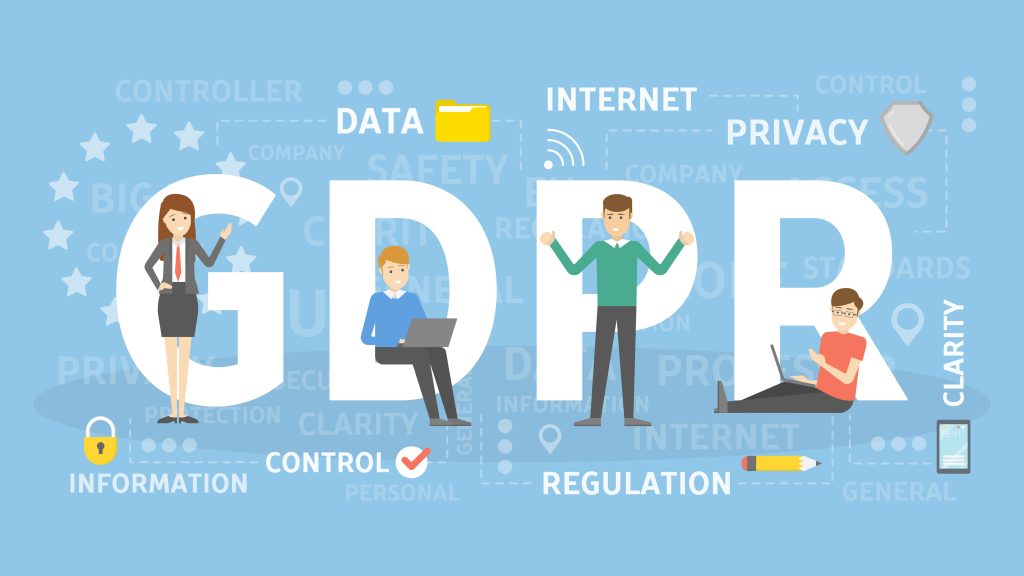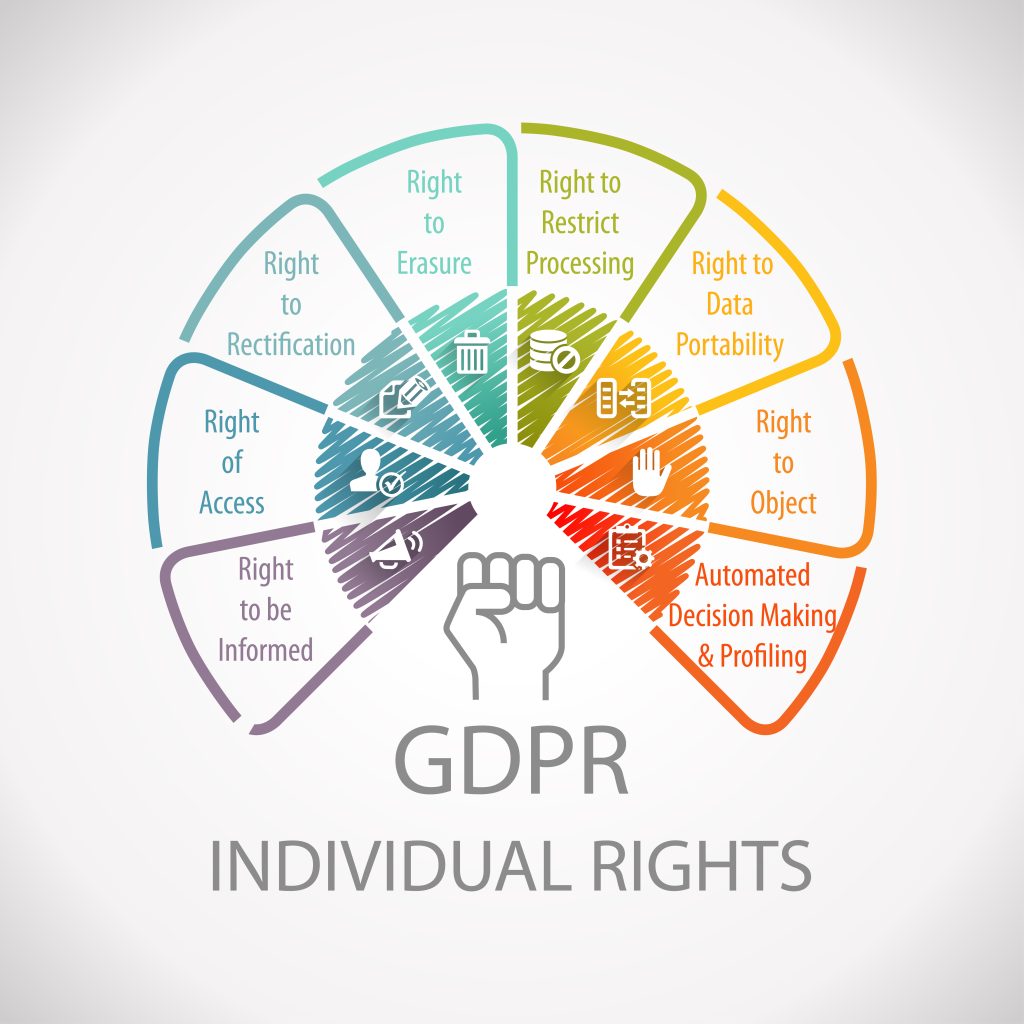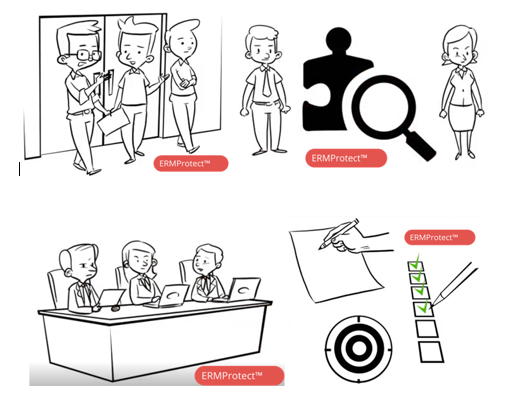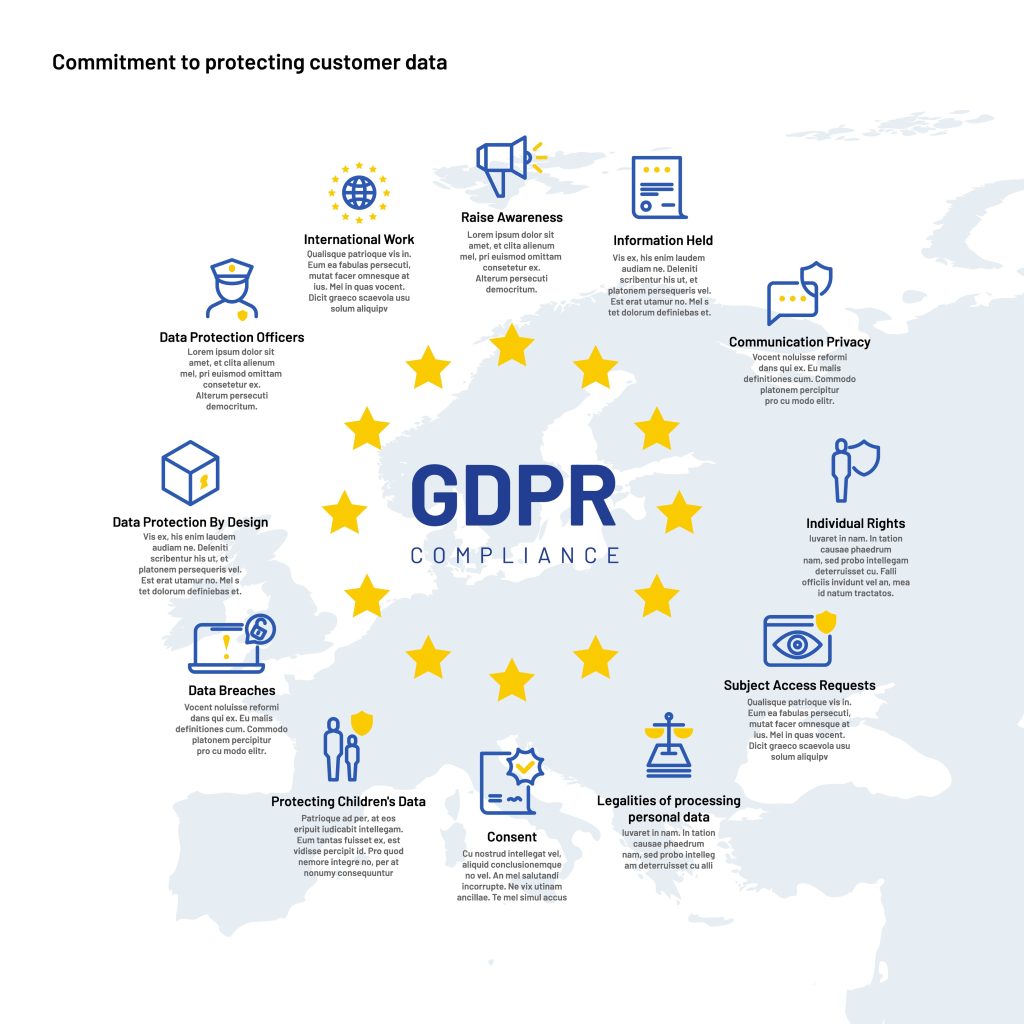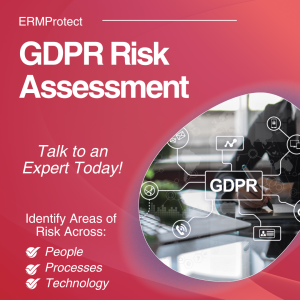GDPR Compliance Checklist: A Guide for U.S. Companies
By Rey LeClerc Sveinsson, PhD
Table of Contents
- Why GDPR Matters to U.S. Companies
- GDPR Compliance Checklist
- Conclusion
- GDPR Compliance Risk Assessments with ERMProtect
The General Data Protection Regulation (GDPR), enacted by the European Union (EU), has set a global standard for data protection and privacy. It is not just European companies that need to comply – U.S. businesses with any economic activity in the EU, or those managing data of EU citizens, must also adhere to these regulations.
Compliance is not merely a legal formality - it is vital to safeguarding user data and maintaining the trust of customers.
This article provides a GDPR compliance checklist to guide U.S. companies through a gap analysis and underscores the importance of GDPR compliance.
Why GDPR Matters to U.S. Companies
- Access to the European Market
The European Union (EU) is one of the largest and most affluent economic areas in the world, boasting a consumer base of over 500 million people. For U.S. companies, access to this market is contingent upon compliance with the EU’s stringent data protection laws, embodied in the GDPR.
Non-compliance can result in significant barriers to entry, including restrictions or outright bans on conducting business within the EU. Adhering to GDPR not only ensures legal access but also facilitates smoother operations and interactions within this lucrative market.
Given the integrated nature of global digital services and supply chains, even companies without a physical presence in the EU might find themselves obligated to comply if they process data related to EU residents.
- Enhanced Trust and Reputation
In an era where data breaches and privacy concerns frequently make headline news, GDPR compliance serves as a badge of honor. It signals to customers and partners that a company is serious about protecting personal data. This commitment can elevate a company's reputation and strengthen consumer trust, which are critical components of customer loyalty and brand value.
By embedding strong privacy standards into their operations, U.S. companies not only meet regulatory requirements but also differentiate themselves from competitors. This trust is especially important for new market entrants and technology firms whose business models rely on the processing of large volumes of personal data.
- Financial Risks
The financial implications of GDPR non-compliance are severe. Fines for violating these regulations can reach up to 4% of annual global turnover or €20 million, whichever is greater.
These penalties are designed to enforce compliance but can also jeopardize the financial stability of a business. Beyond fines, non-compliance can lead to other financial consequences such as litigation costs, compensatory payments to affected parties, and the loss of business as consumers and partners move to compliant competitors.
For U.S. companies, the potential financial risks extend beyond immediate fines; they include long-term revenue impacts from damaged customer relationships and brand devaluation.
In summary, GDPR compliance is crucial for U.S. companies not just to avoid penalties but as a strategic component of global business operations. It enables access to one of the world's largest markets, enhances trust and competitive advantage, and protects against significant financial and reputational risks.
GDPR Compliance Checklist
To effectively conduct a GDPR gap analysis, U.S. companies should consider the following key areas:
1. Data Protection Officer (DPO)
Under GDPR, the appointment of a Data Protection Officer (DPO) is mandatory for organizations that engage in large-scale systematic monitoring of individuals or large-scale processing of sensitive personal data. For U.S. companies, determining the necessity of a DPO is a crucial first step in GDPR compliance. This assessment should consider the nature, scope, and scale of data processing activities:
- Nature of Data: Does the company process data that is considered sensitive under GDPR, such as health information, racial or ethnic data, or political opinions?
- Volume and Frequency: Are the data processing activities large in scale, both in terms of volume and frequency? This includes not only customer data but also data related to employees and other stakeholders.
- Systematic Monitoring: Does the company engage in systematic monitoring of data subjects? This can include tracking individuals' online activities or using CCTV systems extensively.
If any of these conditions apply, appointing a DPO becomes obligatory. Even if not legally required, having a DPO might still be beneficial for ensuring GDPR compliance and managing broader data protection responsibilities efficiently.
Ensuring DPO Effectiveness
Once the need for a DPO is established, the next critical step is ensuring that the individual appointed as the DPO has the necessary resources and expertise to perform their duties effectively. This includes:
- Knowledge and Expertise: The DPO should have a thorough understanding of GDPR requirements as well as other relevant data protection laws. This expertise should be complemented by knowledge of the company’s sector-specific challenges and data processing operations.
- Authority and Independence: The DPO must have the authority to perform their duties without any conflict of interest. This means they should report to the highest management level and have direct access to decision-makers. It is vital that the DPO engages in all issues related to data protection.
- Resources: Adequate resources must be allocated to the DPO to fulfill their responsibilities. This includes access to necessary technology, funding for ongoing training, and a team if the scale of data processing operations demands it.
- Visibility and Accessibility: The DPO should be accessible to every individual whose data is processed, including employees, customers, and regulatory authorities. This accessibility is crucial for handling inquiries, complaints, and communicating with stakeholders about data protection issues.
By carefully assessing the need for a DPO and ensuring they are well-equipped and empowered, U.S. companies can better manage their GDPR compliance obligations. An effective DPO not only helps in maintaining compliance but also plays a pivotal role in fostering a culture of data protection within the organization.
2. Data Inventory and Mapping
A comprehensive data inventory is a cornerstone of GDPR compliance. This inventory serves as a detailed map of all personal data that a U.S. company collects, processes, and stores, regardless of whether the data pertains to EU citizens or residents. Key elements of this data inventory should include:
- Data Identification: List all types of personal data the company manages. This could include names, addresses, email addresses, IP addresses, health information, and more.
- Data Origin: Record where each type of data comes from. Was it collected directly from data subjects, or obtained through third parties? Understanding the source is crucial for compliance with GDPR's transparency requirements.
- Purpose of Data Collection: Specify the exact purpose for which each type of data is collected and processed. GDPR requires that personal data must be collected for specified, explicit, and legitimate purposes.
- Data Sharing: Document who the data is shared with, including third parties and cross-border data transfers. This includes service providers, affiliates, and others. The legal and compliance implications of data sharing, especially internationally, must be carefully managed.
- Data Storage and Retention: Note where the data is stored and how long it is kept. GDPR mandates that personal data should not be kept longer than necessary for the purposes for which it is processed.
Creating this inventory not only aids in compliance but also prepares the company for potential audits by regulatory authorities and provides clarity in the event of data breaches.
Evaluating the Legal Basis for Data Processing Activities
Each data processing activity must have a clear legal basis under GDPR. U.S. companies must evaluate and document the basis for processing personal data, ensuring compliance with one of the allowable conditions:
- Consent: Has the data subject given clear and informed consent for the data processing? Consent must be freely given, specific, informed, and unambiguous under GDPR, with easy options for withdrawal.
- Contractual Necessity: Is the processing necessary for the performance of a contract to which the data subject is party? For example, processing customer addresses to deliver goods.
- Legal Obligation: Is processing required to comply with a legal obligation? This might include financial data processing for tax purposes.
- Vital Interests: Is the processing necessary to protect an interest which is essential for the life of the data subject or that of another person?
- Public Interest or Official Authority: Is the processing necessary for the performance of a task conducted in the public interest or in the exercise of official authority vested in the controller?
- Legitimate Interests: Does the company have a legitimate interest in processing the data that does not override the rights and freedoms of the data subjects? This basis requires a careful balance test to ensure that interests of the data subjects are not harmed.
Thorough documentation and regular review of the legal bases for data processing are essential. This not only ensures ongoing compliance but also helps in maintaining transparency and accountability in data processing activities.
3. Consent Management
Consent management is a critical aspect of GDPR compliance, particularly for U.S. companies operating in or serving the European market. The procedures for obtaining and recording consent must adhere to GDPR's stringent standards, which are designed to ensure that consent is given freely, is well-informed, and is unambiguous. Key steps in reviewing these procedures include:
- Clarity and Specificity: Consent requests must be presented in a clear, concise, and easily accessible form. The language used should be simple and free from legal jargon, ensuring that the data subjects fully understand what they are consenting to.
- Separation from Other Terms: Consent should not be bundled as a condition of service unless it is necessary for that service. This means separating consent requests from other terms and conditions to avoid “forced consent.”
- Active Opt-In: Consent must be given through an affirmative action that signifies agreement, such as ticking a box or choosing settings online. Pre-ticked boxes or inactivity should not be construed as consent.
- Documenting Consent: Each instance of consent must be recorded, detailing what the data subject consented to, when, and how. This record-keeping is vital not only for compliance but also for auditing purposes and managing any disputes about consent.
- Regular Updates and Reviews: Consent must be renewed if the purpose for data processing changes. Regular reviews should be conducted to ensure that the consent is still valid and the information about data processing is still accurate.
Ensuring Easy Withdrawal of Consent
Under GDPR, data subjects have the right to withdraw their consent at any time, and it should be as easy to withdraw as it is to give. This means that U.S. companies must check their systems to ensure they support easy withdrawal of consent:
- Accessible Withdrawal Mechanisms: Ensure that mechanisms for withdrawing consent are clearly accessible and as straightforward as the mechanisms for giving consent. This might include a dedicated section in user profiles, clear instructions on websites, or direct links in emails.
- Immediate Processing: Once consent is withdrawn, the data processing based on that consent must stop immediately. Systems should be configured to promptly process these withdrawals.
- Communication: Data subjects should be informed about their right to withdraw their consent and how they can do so. This information should be part of the initial consent process and readily available on the company’s platforms.
- No Detriment to Data Subjects: Withdrawing consent should not lead to any detriment or less favorable treatment of the data subjects. Companies need to ensure that the withdrawal of consent does not impact the data subject's access to services or products, unless such access is inherently dependent on the data processing that requires consent.
Managing consent effectively under GDPR is not only about compliance but also about building trust with customers by respecting their privacy choices. For U.S. companies, investing in robust consent management procedures and systems is essential for ethical data practices and maintaining a positive relationship with European customers and regulators.
4. Data Subject Rights
The General Data Protection Regulation (GDPR) grants several rights to individuals regarding their personal data, emphasizing the importance of transparency and control over personal information. U.S. companies operating in the EU must have well-defined processes to facilitate these rights:
- Data Access Requests: Implement a mechanism where individuals can request access to their personal data held by the company. This process should enable individuals to see what data is being processed, why, and where it is being stored or transferred.
- Rectification: Set up a straightforward procedure for individuals to have incorrect or incomplete data corrected. This is crucial for maintaining the accuracy of the data held.
- Erasure (Right to be Forgotten): Allow individuals to request the deletion of their data when it is no longer necessary for the purpose it was collected, among other conditions. This process must be managed carefully to balance the individual's rights with any legal requirements for retaining certain types of data.
- Data Portability: Enable individuals to receive the data they have provided in a structured, commonly used, and machine-readable format, and to have it transferred to another data controller. This supports consumer freedom and enhances competition.
Each of these rights requires specific processes that should be tailored to the nature of the data and the business’s operations. Companies should ensure these processes are user-friendly, including providing online forms or dedicated contacts for these requests.
Ensuring Efficiency and Compliance with GDPR Timelines
The efficiency of these processes is crucial, not only for compliance but also for customer satisfaction and trust. GDPR mandates specific timelines for responding to requests from data subjects:
- Response Time: Companies have one month to respond to a request from a data subject. This period may be extended by two further months if the request is particularly complex or if the company receives several requests. If an extension is needed, the data subject should be informed within the first month.
- Notification and Communication: When a data subject exercises one of their rights under the GDPR, the company must not only respond but also act on the request without undue delay. If a company decides not to comply with a request, it must explain why to the data subject, informing them of their right to complain to a supervisory authority and to seek a judicial remedy.
- System Integration: Ensure that the IT systems used for data management can swiftly manage requests from data subjects. This involves having the technical capability to extract, modify, delete, or transmit personal data as needed.
- Training and Awareness: Employees should be trained on the importance of data subject rights and on the processes for managing such requests. This training should cover the legal basis of the rights, the company’s specific procedures for handling requests, and the urgency of complying within the stipulated timeframes.
By establishing and maintaining efficient processes for handling data subject rights, U.S. companies not only adhere to GDPR requirements but also demonstrate a commitment to respecting and protecting individual privacy rights, which is integral to building and maintaining trust in a global marketplace.
5. Data Breach Notification
Under GDPR, one of the most critical requirements for organizations is the obligation to report certain types of data breaches to the relevant supervisory authority within 72 hours of becoming aware of the breach, unless the breach is unlikely to result in a risk to the rights and freedoms of natural persons. This tight deadline makes it essential for U.S. companies to have an efficient and effective breach notification process in place.
Key elements of this process include:
- Detection and Assessment: Implement systems and tools that can quickly identify and assess the severity of data breaches. This includes the use of advanced security software that can detect anomalies in data access or usage.
- Internal Reporting Procedures: Establish clear procedures for staff to follow in the event of a breach, including immediate reporting to designated personnel within the organization. This team should assess the situation rapidly to determine whether the breach needs to be reported to the supervisory authority.
- Notification Protocols: Develop templates and predefined processes for notifying the supervisory authority. The notification must include the nature of the personal data breach, the categories and approximate number of data subjects concerned, and the consequences of the breach. A description of the measures taken or proposed to be taken to address the breach should also be included.
- Communication with Data Subjects: If the breach is likely to result in a high risk to the rights and freedoms of individuals, the company must also communicate the breach to the affected data subjects without undue delay. This communication should be clear and concise, explaining the nature of the breach, the possible consequences, and the measures being taken to mitigate its effects.
Training Staff to Recognize and Respond Appropriately to Data Breaches
Effective handling of data breaches not only relies on established procedures but also on the preparedness of the staff. Training programs are crucial in ensuring that employees can recognize the signs of a data breach and know the steps to take in response:
- Regular Training Sessions: Conduct regular training sessions to educate all employees about the significance of data protection and the specific indicators of data breaches. These sessions should also cover the company’s policies and procedures for reporting and managing breaches.
- Simulated Breach Exercises: Organize simulated data breach scenarios to help staff practice their response in a controlled environment. This helps in identifying weaknesses in the breach response strategy and in reinforcing the importance of quick action.
- Roles and Responsibilities: Clearly define the roles and responsibilities of all staff members in the event of a data breach. Ensure that everyone knows whom to contact immediately if they suspect a breach has occurred.
- Continuous Learning: Keep the training programs updated with the latest threats and real-world breach examples. Cyber threats evolve rapidly, and staying informed is key to maintaining effective defenses.
By developing a robust data breach notification process and ensuring that all staff are trained to manage and report breaches efficiently, U.S. companies can comply with GDPR requirements while minimizing potential harm to both the individuals affected and the organization itself. This proactive approach not only addresses compliance but also contributes significantly to the resilience and reliability of the company in handling personal data.
6. Data Protection Impact Assessments (DPIA)
Data Protection Impact Assessments (DPIAs) are a fundamental requirement under GDPR for processing operations that are likely to result in high risks to the rights and freedoms of natural persons.
For U.S. companies, understanding when a DPIA is necessary is crucial for compliance and for mitigating potential risks associated with data processing activities. Key situations that typically require a DPIA include:
- Large-scale Processing of Sensitive Data: This includes extensive processing of personal data related to racial or ethnic origin, political opinions, religious beliefs, trade union membership, genetic data, biometric data for unique identification, health information, or data concerning a person's sex life or sexual orientation.
- Systematic Monitoring: Operations that entail systematic monitoring of individuals, especially in a publicly accessible area. This can include the use of CCTV systems or other forms of surveillance.
- Data Matching or Combining: Processes where datasets from different sources are combined, assessed, or analyzed in a way that would have significant implications for individuals’ privacy.
- Automated Decision-Making with Legal or Similar Effects: Processing activities designed to make automated decisions, including profiling, which produce legal effects concerning the individual or significantly affect the individual.
- Data Transfer Across Borders: Particularly where personal data is transferred outside the EU to countries whose data protection laws are not deemed adequate by the European Commission.
Identifying these situations involves thorough analysis and consultation with data protection experts, legal teams, and potentially the Data Protection Officer (DPO) to ensure that all high-risk processing activities are covered.
Regularly Conducting DPIAs
Once situations requiring a DPIA have been identified, U.S. companies must ensure that DPIAs are not only conducted initially but are also part of an ongoing risk management process. Regularly conducting DPIAs involves:
- Initial Assessment: Before starting a new data processing activity identified as high risk, a DPIA must be conducted. This assessment should map out the processing operations, assess the necessity and proportionality of the processing, and evaluate risks to the rights and freedoms of data subjects.
- Mitigation Measures: The DPIA should identify measures to mitigate identified risks, such as data minimization, data masking, enhanced security measures, and safeguards against data breaches.
- Consultation: If the DPIA indicates that the data processing would result in a high risk that cannot be sufficiently mitigated, GDPR mandates that the company consults with the relevant supervisory authority before proceeding.
- Regular Reviews: DPIAs should be reviewed and updated regularly, particularly when there are changes in the nature, scope, context, or purposes of the data processing. Regular reviews ensure that the DPIA remains relevant and that all new or previously unassessed risks are managed effectively.
By integrating DPIAs into their regular data governance practices, U.S. companies can not only ensure GDPR compliance but also maintain robust protections for the personal data they process. This proactive approach to GDPR compliance risk assessment and mitigation is critical in maintaining the trust of stakeholders and protecting the rights of individuals.
7. Third-party Management
For U.S. companies operating within or dealing with data from the European Union, managing third-party relationships is crucial under GDPR. Third parties and vendors who process personal data on behalf of a company must be held to the same data protection standards as the company itself.
This requires meticulous evaluation and management of all contracts involving data processing activities:
- Contractual Clauses: Ensure that contracts with third parties include specific clauses that mandate compliance with GDPR. These clauses should detail the nature and purpose of data processing, the obligations of the third parties, and the rights of data subjects.
- Data Processing Agreements (DPAs): Formalize relationships with vendors through DPAs that clearly define roles, responsibilities, and data protection expectations. DPAs should also stipulate the measures that third parties must take to protect personal data, including data security, data breach notification procedures, and data transfer restrictions.
- Liability and Indemnity: Contracts should address liability issues in the event of a data breach or non-compliance, including indemnity clauses where appropriate. This is crucial for mitigating potential financial and reputational damage.
Conducting Audits and Due Diligence to Verify Third-party Compliance
Merely establishing contracts is not sufficient to ensure GDPR compliance. Regular audits and due diligence are necessary to verify and enforce third-party compliance:
- Initial Due Diligence: Before entering into agreements, conduct thorough due diligence to assess the GDPR compliance posture of potential third-party vendors. This includes reviewing their data protection policies, past compliance records, and security measures.
- Regular Audits: Schedule regular audits of third-party operations to ensure ongoing compliance. These audits can be conducted internally or by independent external auditors. The focus should be on assessing how personal data is managed, stored, and protected.
- Risk Assessment: As part of the audit process, conduct a GDPR compliance risk assessment to identify any potential vulnerabilities or non-compliance issues. This helps in prioritizing the areas that need immediate attention.
- Remediation and Follow-up: If audits reveal any compliance gaps, set up a clear plan for remediation with specific timelines. Regular follow-ups are necessary to ensure that the third party addresses all identified issues within the agreed timeframe.
- Transparency and Communication: Maintain open lines of communication with third parties about GDPR compliance requirements. Providing guidance and support can help vendors understand and meet compliance standards effectively.
By rigorously evaluating and managing third-party relationships through contracts and regular audits, U.S. companies can extend their GDPR compliance framework beyond their immediate operations. This not only helps in mitigating risks associated with data breaches and non-compliance but also strengthens the overall data protection strategy, building a stronger foundation of trust with customers and regulators.
8. Data Security
To ensure compliance with the General Data Protection Regulation (GDPR), U.S. companies must regularly assess and upgrade their data security measures. This involves a series of steps tailored to meet the high standards set by the regulation:
- Security Audits: Conduct comprehensive security audits to evaluate the current security landscape and identify vulnerabilities in the system. This should include both physical security measures and IT infrastructure.
- Risk Assessment: Perform detailed GDPR compliance risk assessments to understand the potential threats to personal data and evaluate the effectiveness of existing security measures. This helps in prioritizing security upgrades and mitigating risks efficiently.
- Implementation of Upgraded Security Technologies: Based on the findings from the audits and GDPR compliance risk assessments, deploy advanced security solutions such as firewalls, intrusion detection systems, and secure access management technologies.
- Compliance with GDPR Requirements: Ensure that all security upgrades comply with GDPR requirements, which emphasize the protection of personal data from unauthorized access, accidental loss, destruction, or damage.
Implementing Advanced Technologies
To further enhance data security, companies should consider integrating advanced technologies that add layers of protection to the handling and storage of personal data:
- Encryption: Use encryption technologies to protect data both at rest and in transit. This ensures that personal data is unreadable and unusable to unauthorized persons. Encryption is highly recommended under GDPR for any data that would pose a risk to individual rights and freedoms if exposed.
- Anonymization: Where appropriate, anonymize data to remove personally identifiable information permanently. Anonymization helps reduce privacy risks and lessens GDPR compliance requirements because anonymized data is no longer considered personal data.
- Pseudonymization: Although like anonymization, pseudonymization allows data to be de-linked from specific data subjects but not completely stripped of personal identifiers. This technique allows for more flexible use of the data while still protecting the identities of individuals.
- Regular Updates and Patch Management: Keep all systems up to date with the latest security patches and updates. Regular updates are essential to protect against known vulnerabilities and attacks.
Best Practices for Data Security Under GDPR
- Develop a Data Security Policy: Create a clear data security policy that outlines how personal data should be managed, protected, and securely processed. This policy should be communicated to all employees and enforced as part of the organization’s GDPR compliance efforts.
- Employee Training and Awareness: Regularly train employees on data security best practices and the importance of GDPR compliance. Employees should understand their roles in protecting personal data and the potential consequences of data breaches.
- Data Security as Part of the Data Lifecycle: Integrate data security considerations throughout the data lifecycle, from data collection and storage to transfer and deletion. This ensures continuous protection of personal data in accordance with GDPR guidelines.
Implementing these security measures and technologies not only helps in achieving compliance with GDPR but also builds trust with customers and stakeholders by demonstrating a commitment to safeguarding personal data.
9. Training and Awareness
Training and awareness are pivotal in ensuring GDPR compliance. Employees are often the first line of defense against data breaches and non-compliance; therefore, regular training is crucial:
- Comprehensive GDPR Training: Conduct training sessions that cover all aspects of GDPR, from basic principles to specific data protection practices that pertain to different roles within the organization. This includes understanding what constitutes personal data, the rights of data subjects, and the obligations of data controllers and processors.
- Role-Specific Training: Tailor training sessions to the roles and responsibilities of different employee groups within the organization. For example, marketing teams need to understand the nuances of consent, while IT staff need to be aware of data security best practices.
- Regular Updates: GDPR is not static; regulatory guidance and case law evolve over time. Regular training updates are necessary to keep staff informed of new developments and refresh their knowledge of core principles.
Fostering a Data Protection Culture
Creating a culture of data protection within an organization goes beyond mere compliance. It involves embedding data privacy into the corporate ethos:
- Leadership Involvement: Leaders should demonstrate a commitment to data protection, setting a tone at the top that emphasizes the importance of GDPR compliance. Leadership can champion data protection initiatives and ensure that adequate resources are allocated to protect personal data.
- Engagement Activities: Utilize regular communications, workshops, and even gamified learning experiences to keep data protection top of mind. Activities could include data protection challenges or quizzes that reinforce key GDPR concepts.
- Recognition and Rewards: Implement a system to recognize and reward compliance-enhancing behaviors. This can encourage employees to take data protection seriously and function as role models for their peers.
- Feedback Mechanisms: Establish clear channels through which employees can report potential data protection issues or suggest improvements. An open-door policy for data protection concerns can help catch issues before they escalate into serious compliance risks.
Continuous Improvement
Maintaining an effective training and awareness program requires continuous evaluation and improvement:
- Assess Effectiveness: Regularly evaluate the effectiveness of training programs through tests, surveys, and feedback. Understanding what employees have learned and where gaps remain can help in refining the training content and delivery methods.
- Stay Informed: Keep abreast of the latest best practices in training and awareness from GDPR regulators, industry groups, and data protection authorities. Applying these best practices can enhance the training program’s effectiveness.
- Adapt to Changes: Be responsive to changes in the regulatory environment, technology, and business operations. Training and awareness programs should be dynamic and adaptable to reflect these changes.
In conclusion, training and awareness are integral to GDPR compliance. By regularly educating employees and fostering a culture that values data protection, organizations can not only comply with the law but also protect themselves from data breaches and enhance their reputation for respecting customer privacy.
10. Documentation and Record Keeping
Effective documentation and record keeping are essential under GDPR, serving both compliance and operational needs:
- Comprehensive Documentation: Maintain detailed records of all data processing activities. This includes the type of data collected, the purpose of processing, the categories of recipients who receive the data, and any transfers of data to third countries. This documentation must be readily available to demonstrate compliance in case of inspections by regulatory authorities.
- Data Protection Impact Assessments (DPIAs): Document all DPIAs conducted, including the processes evaluated, the risks identified, and the mitigating actions taken. DPIAs are critical for high-risk data processing activities and must be updated when significant changes occur that affect data processing.
- Consent Records: Keep meticulous records of how and when consent was obtained from data subjects. This should include information on the specific details provided to the data subjects at the time of consent, how consent was collected (e.g., via checkbox, written form, online form), and any subsequent withdrawals of consent.
Regularly Review and Update Data Protection Policies and Procedures
To ensure ongoing compliance with GDPR and to adapt to changing business needs or regulatory landscapes, regular reviews and updates of data protection policies and procedures are necessary:
- Scheduled Reviews: Establish a regular schedule for reviewing data protection policies and procedures. This could be annually or biannually, depending on the organization's size, the volume of data processed, and how dynamic the business environment is.
- Update Mechanisms: Implement mechanisms to promptly update policies and procedures when there are changes in legal requirements, technological developments, or operational changes that impact data processing activities.
- Involvement of Stakeholders: Engage various stakeholders in the review process, including legal, compliance, IT, and business units, to ensure that all aspects of data protection are considered and addressed.
- Training on Updates: Once updates are made, communicate these changes to all employees and provide necessary training to ensure understanding and compliance.
Benefits of Proper Documentation and Record Keeping
- Regulatory Compliance: Proper documentation helps in demonstrating compliance with GDPR, making it easier to respond to inquiries from data protection authorities.
- Operational Efficiency: Well-maintained records enable more efficient management of data processing activities, facilitate the assessment of data protection impacts, and help in responding to data subject requests effectively.
- Risk Management: Comprehensive documentation and regular updates of policies reduce the risk of data breaches and non-compliance, as they ensure that safeguards are current and in line with the latest data protection standards.
Overall, maintaining rigorous documentation and regularly updating data protection policies are not just regulatory requirements but also best practices that enhance an organization's ability to protect personal data and manage privacy risks effectively.
GDPR Compliance is Essential
For U.S. companies, adhering to the GDPR is far from merely a regulatory obligation - it is an essential aspect of conducting business within the European market and beyond.
The digital age has eroded traditional geographical boundaries, making data privacy a critical global issue. As such, GDPR compliance should be viewed as a key component of a company's international strategy, particularly when engaging with the European market where consumer data protection standards are exceptionally high.
Implementing a thorough GDPR compliance gap analysis using a comprehensive GDPR compliance checklist, as outlined above, is the first step in identifying potential areas of non-compliance. This analysis is not just a regulatory audit. It is a strategic review of how data is managed, protected, and leveraged within a company.
By pinpointing deficiencies, companies can implement targeted adjustments to their data handling and processing protocols, ensuring compliance with EU standards.
This proactive approach to GDPR compliance does more than just mitigate legal and financial risks - it also boosts corporate integrity. Demonstrating a commitment to data protection enhances a company's reputation, fostering trust among consumers and business partners alike. This trust is vital in today's economy where consumers are increasingly aware of and concerned about their personal data’s security.
Furthermore, GDPR compliance enhances customer loyalty. Customers are more likely to remain with companies they believe are safeguarding their personal information responsibly and ethically. Eventually, this loyalty translates into sustained revenue streams and a competitive advantage in both the European market and globally.
Finally, embracing GDPR compliance lays a solid foundation for global business operations. It prepares companies not only for current regulatory environments but also for potential future regulations in other regions.
As more countries and regions consider adopting similar data protection laws, being ahead in GDPR compliance could provide U.S. companies with a smoother transition and a sustainable business model in an increasingly data-conscious global marketplace.
GDPR Compliance Risk Assessments with ERMProtect
ERMProtect offers a range of services that can significantly aid in GDPR compliance and enhance overall cybersecurity for organizations.
ERMProtect conducts thorough GDPR compliance gap assessments to determine your organization's current GDPR compliance status and identifies areas of risk across people, processes, and technology.
We then help develop a practical roadmap and action plan for achieving full compliance, ensuring all necessary GDPR elements such as governance, accountability, and the role of the Data Protection Officer are adequately addressed.
ERMProtect's comprehensive approach to GDPR compliance risk assessment not only targets technical and operational compliance with GDPR, but also focuses on building a robust privacy and security culture within your organization. This holistic method is essential for maintaining long-term compliance and safeguarding against emerging cybersecurity threats.
We hope you found this GDPR compliance checklist useful. For more information or a free consultation, please contact [email protected] or call 305-447-6750.
About the Author
Dr. Rey Leclerc Sveinsson is an expert in Privacy and Data Protection, Information Security, and Technology Governance, Risk & Compliance (IT GRC). He has developed information assurance programs for major organizations globally during his career as well as serving as a Consultant for ERMProtect. He has a PhD in Information Systems and multiple master’s degrees in the areas of privacy, information technology, and cybersecurity laws.
Intelligence and Insights

Aligning Your Incident Response Plan with NIST SP 800-61 Rev. 3

CEO Checklist: How To Know If Your Organization Is Cyber Secure






